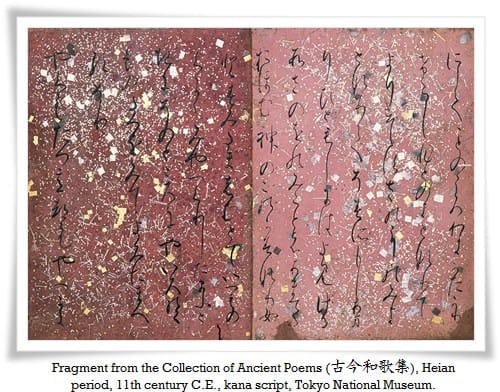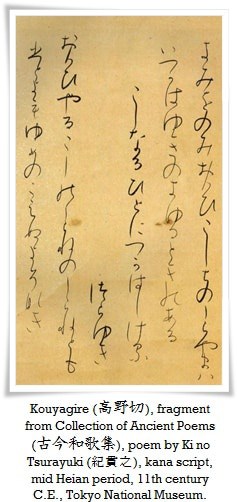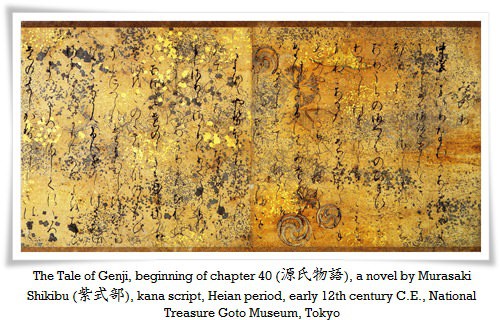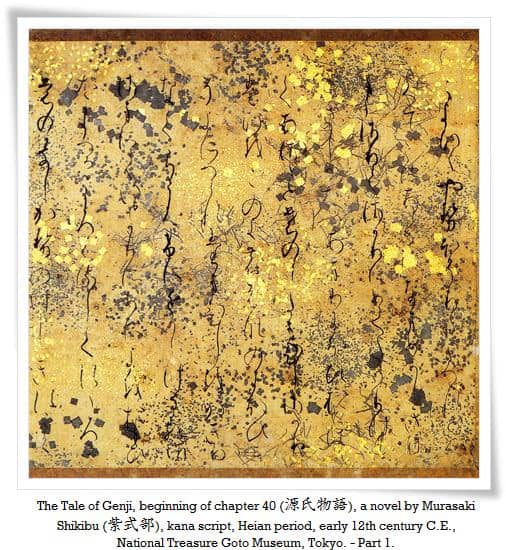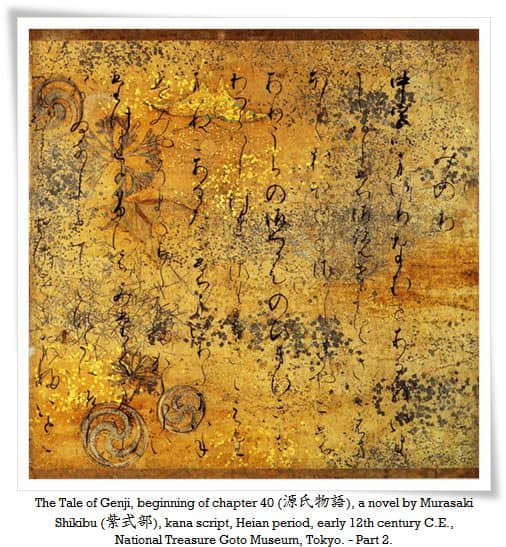Kana (仮名) in Japanese means “syllabary”, therefore a writing system of whose symbols or characters have a purely phonetic nature, and each of them represents a syllable. Kana in Japanese has many variations (such as hentaigana, 変体仮名 – lit. anomalous kana), though only two of them are used today in everyday communication. In calligraphy on the other hand, it is not unusual to write in any of the old styles.
Modern Japanese language consists of two types of kana (hiragana 平仮名, and katakana 片仮名), and kanji (漢字, lit. characters of Han China). The latter is a logographic script, which in opposition to kana, can have complex pictographic semantic and phonetic nature.
Allow me to illustrate it with a simple example. Let us say we want to write down the word “harmony”. In Japanese it is written in kanji as 和(wa), hiragana わ(wa), or katakanaワ(wa). A perfectly natural question is, why anyone would need three writing systems (please note that neither kanji nor kana are alphabets.). The answer lies in both history and linguistics.
Kanji is a writing system imported from China in approximately the 5th century C.E., although single characters started to appear in Japan on imported goods from China as early as the 1st century C.E. However, since Japanese language has completely different grammatical rules to Chinese, a need for a supplementary writing system appeared. The answer to this problem was hiragana, developed out of cursive manyougana (万葉仮名, lit. “kana of ten thousand leaves”), used to write words (suffixes, particles, etc) for which there are no kanji. Cursive manyougana is called sougana (草仮名, lit. draft kana). To simplify it, the evolution of Chinese writing system, it looked as follows: kanji -> manyougana -> sougana -> hiragana.
The cradle of hiragana is considered to be late the 5th century, when its predecessor manyougana came into use. The creation of hiragana is often attributed to possibly the greatest Japanese calligrapher of all times, a Shingon priest (真言宗, Shingon is a major Japanese Buddist school) and Sanskrit scholar Kūkai (空海, 774–835). Kukai, together with Emperor Saga (嵯峨天皇, 786–842) and Tachibana no Hayanari (橘逸勢, 782-842), was one of the famous “three brushes” (三筆, sanpitsu) of the 9th century. Each of them had a profound influence on the development of calligraphy in Japan. They also laid the foundations for wayou shodou (和様書道), a purely Japanese style of sho (書, calligraphy), whose ideas were materialized by Ono no Michikaze (小野道風, 894–966) a century later.
Kata kana was also created around the 9th century during the Heian period (平安時代, 794 – 1185), and today it serves as a syllabary for writing foreign words, names, etc. Both kana scripts have identical sounds, though their appearances differ. Kata kana was developed from kanji compounds written in standard script (楷書, kaisho), whereas hiragana was based on cursive script (草書, sousho). For that reason, hiragana may seem more smooth and supple than kata kana.
Hiragana in calligraphy is commonly known as onnade (女手, lit. woman’s hand) as originally, it was used mainly by women. In feudal Japan, females had no access to higher levels of education. In later periods men begun to write poetry in kana, including hiragana combined with kanji in cursive script, which is known as chouwatai (調和体, lit. “a harmony of bodies”, i.e. scripts), and its popularity expanded. Chouwatai may involve both kana’s.
Katakana is known as otokode (男手, lit. “man’s hand”) since it was derived from standard script of kanji. Kanji were the domain of men. Katakana is rarely used in calligraphy.
Hiragana has eventually replaced troublesome manyougana, which, as you may remember, is nothing else but selected kanji playing purely phonetic roles in a sentence. Imagine the confusion and issues with reading a text, especially since in 12th century there were around 1000 of manyougana characters in use.
A single kanji may have up to 30 readings or more, not to mention meanings, and all of them bear strong and multiple semantic associations to ideas, situations or states. While reading a passage in manyougana, one never really knows whether a given character is meant to be read phonetically or is actually supposed to influence the meaning of a sentence. On the other hand, this is one of the wonders of calligraphy, that instead of focusing on reading it, one should sense it.
Today, by kana in calligraphy we mean a highly cursive script consisting purely of kana (or more precisely, hiragana), or kana and kanji merged together. The latter, in Japanese is, as mentioned above, referred to as chouwatai.
Due to language specifics, kana is a calligraphy style practiced only in Japan. It is an incredibly charming, graceful, and delicate script. Kana text flowing through a page of paper, be it pure white or even lavishly ornamental, resembles a translucent thread of incense smoke gently climbing in the still air, bouncing off its small particles like in a fantasy dream. Just by looking at a kana masterpiece, even without knowing or understanding its meaning, one can shed a tear of aesthetical appreciation.
Kana demands of an artist a vast knowledge of cursive script (草書, sousho). In calligraphy, student progresses from standard script (楷書, kaisho) and clerical script (隷書, reisho) to semi-cursive (行書, gyousho), and finally to cursive script. It may take a few years of diligent practice until one is ready to begin studies of kana. Further, kana requires a great control of the brush as it is held by the fingertips at the end of the shaft by means of the hanging arm technique (懸肘, kenwan), with the elbow suspended in the air. Since calligraphy ought to be written with the very tip of the brush, a microscopic movement of the wrist can apply drastic changes in the appearance of the line. Studies of kana and kanji are usually separate subjects in calligraphy. Mastery of both is difficult to impossible, and definitely takes up an entire lifetime.
The most famous work and at the same time the first novel in kana is The Tale of Genji (源氏物語, Genji Monogatari), attributed to the Japanese noblewoman, Murasaki Shikibu (紫式部; c. 973 – c. 1014 or 1025). It is often referred to as the world’s first novel. The Tale of Genji is about the life of the emperor’s son. A fragment of the text appeared on a year-2000 Japanese Yen banknote, issued for the occasion of celebrating the second millennium.

